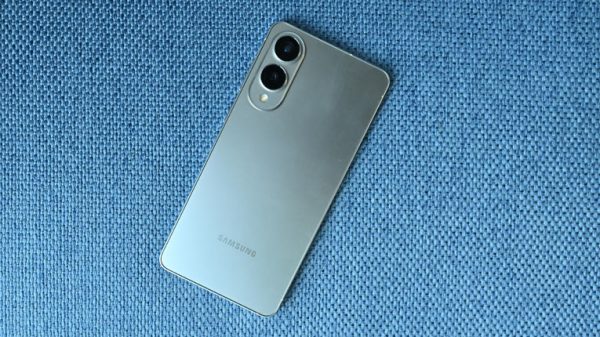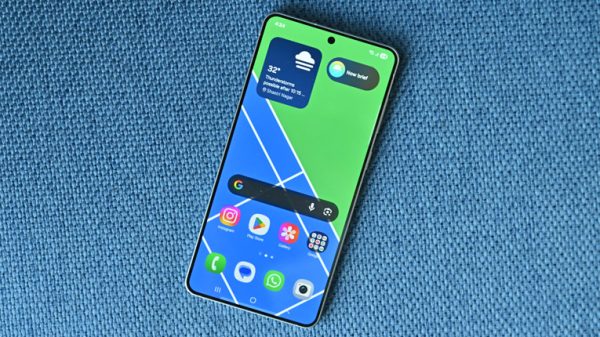Samsung Galaxy S25 Ultra
The Galaxy S25 Edge is a bold and refreshing move from Samsung, standing out not with gimmicks, but with pure design ambition. Its impossibly slim form factor and lightweight body don’t just look good—they redefine everyday practicality in ways you don’t expect until you’ve lived with it. While that sleekness comes at the cost of battery endurance and a missing telephoto camera, Samsung has managed to strike a fine balance by retaining high-end essentials like a class-leading display, excellent performance, and strong camera output from its 200MP main sensor. The AI-powered software experience only strengthens its premium appeal. At ₹1,09,999, the S25 Edge isn’t just Samsung’s thinnest flagship—it’s also a statement of engineering finesse, offering a unique blend of elegance and flagship muscle for those who want something different without giving up on performance. Just be ready to carry a charger if you're a power user.
The Good
- Exceptional design and portability
- Flawless display
- Impressive performance
- AI-Enhanced software
The Bad
- Limited battery life for power users
- No dedicated telephoto lens
-
Design
-
Display and Sound
-
Peformance
-
Camera
-
Software (AI)
-
Battery Life
In the flagship smartphone space, competition is hard to keep up with.
And it’s this daily grind that leads to some of the most peculiar products out there.
Think about it! At no point over the last few years has there been a big demand for an extremely thin Galaxy flagship.
Yet, with the threat of the iPhone 17 Air looming in the foreground, Samsung just had to make the first move.
The result of this move is the Galaxy S25 Edge, the thinnest Galaxy S smartphone ever.
Some extreme engineering has gone into achieving this thickness, although this also means some compromises have been made as well.
But where there’s no compromise at all is in the pricing.
At Rs 1,09,999, the phone sits between the S25 Plus and the S25 Ultra and makes itself look like the crown jewel of Samsung’s design evolution.
This review should help you understand whether the Galaxy S25 Edge is more than just a statement piece.
Design

Practicality is an aspect of smartphone usage that we tend to ignore, but every once in a while, a device comes out that makes us realise how much we were missing a certain facet.
Something similar happened to me a few hours after I started using the Galaxy S25 Edge.
The general habit of feeling something in my denim pocket sent me into a sudden panic.
I immediately tapped my pocket, only to realise that the phone was right there; I just didn’t feel the device due to its slim and lightweight nature.
So this is one aspect that’s worth taking note of. Carrying the Galaxy S25 Ultra in your pocket is extremely comfortable.
And it’s all thanks to its 5.8 mm thin profile and its 163 g weight.
What I noticed is that the novelty of the thinness wears off after a day or two, but you’re still left shocked at how light the phone is, especially if you’re someone like me who always has a second phone in their other pocket.
And why Samsung deserves huge praise is that this has been achieved despite the use of a titanium frame and premium glass on both sides.
Moving to the overall look of the handset, it isn’t a surprise that the circular camera housings of the regular S25 series have been shunned for a pill-shaped design, a la the iPhone 16.

The Apple influence is still strong across the entire industry.
The rear surface is covered with Gorilla Glass Victus 2, but the front has opted for Gorilla Glass Ceramic 2, which has been built to specifically enable thinner form factors, while retaining the regular properties of a Gorilla Glass coating.
Speaking of this front surface, it gets a 6.7-inch panel, with its top pierced with a hole-punch to accommodate the front camera.
The bezels around this screen are shockingly thin, and they really contribute a great deal to its immersiveness.
The under-display fingerprint scanner is quick, while the placements of the volume and power keys are also satisfyingly appropriate.
Overall, the design of the Galaxy S25 Edge comes across as a blend of innovation and practicality.
Display and Sound

You don’t fix something that’s already top-notch, so Samsung has given the Galaxy S25 Edge the same LTPO AMOLED 2X screen as the rest of the S25 Ultra.
The dynamic 120Hz refresh rate and the dense 1,440 x 3,120 pixel resolution make you completely forget that displays are made of pixels.
Its high contrast nature makes it ideal for outdoor use, showing in splendid detail all your necessary visuals, even under direct sunlight.
This is made possible by the 2600 nits of peak brightness that this AMOLED panel can achieve.
Quite honestly, there’s absolutely nothing to complain about when it comes to displays on Galaxy flagships, and this one is no different.
The stereo speaker pair onboard the phone is also top-notch.
Located in the earpiece and at the bottom, this pair creates a depth-filled listening experience.
Whether it’s gaming or viewing videos, or even streaming movies and TV shows, I never found this phone’s speaker system lacking richness.
Performance

There’s a certain expectation when you pick up a premium Galaxy S phone, and performance is a big part of that.
The Galaxy S25 Edge, with its Snapdragon 8 Elite (3nm) chip and 12GB of RAM, delivers on that expectation with confidence.
It blazes through everyday tasks and doesn’t hesitate during heavier tasks as well.
To compare benchmarks, this handset actually fares slightly better than the Galaxy S25 Ultra. It got a single-core score of 3172, against the Ultra’s 3057, while its multi-core score was 9960, against the Ultra’s 9591.
There’s a big gap in the GPU benchmark as well; the Galaxy S25 Edge scored 18785, while the S25 Ultra scored 17996.
That said, one major concern for those buying such a slim device will definitely be how good its thermal management is.
Samuisng claims to have given it a reconfigured vapour chamber that’s both thinner and broader, giving it steady heat dissipation.
I guess this has worked, since I encountered no heating issues during my time with the device.
Camera

The Galaxy S25 Edge doesn’t break new ground with its camera setup, but it does borrow some of the best bits from its siblings.
You get the same 200MP main sensor as the Galaxy S25 Ultra and a 12MP ultra-wide camera that’s identical to the one on the Plus model.
Notably missing is a dedicated telephoto lens.
But if you only use the telephoto mode for zooming in, you have nothing to worry about.
This phone’s zoom performance is strikingly great, even in low light.
Thanks to the large main sensor, shots at 2X and even 4X retain good detail, although pushing beyond that quickly leads to a noticeable drop in quality.
Portrait mode is limited to 1X and 2X, which is fairly standard for phones without a telephoto lens.
Photos clicked with the Galaxy S25 Edge come with Samsung’s signature colour tuning, which includes a slightly punchy profile that’s never overdone.
On gloomy or rainy days, the saturation is more subtle, but still present.
The image processing also deserves some praise. Samsung’s software takes an extra moment to process zoomed shots, transforming them from initially soft previews into sharper final images.
The ultra-wide camera is competent, but it doesn’t match the main sensor.
You’ll see a drop in detail, some inconsistencies in colour, and occasional issues with blown highlights.
Selfies are solid, and you won’t notice much difference from the rest of the S25 lineup.
Video recording is another highlight.
The footage is well-stabilised, with vibrant colours and smooth transitions.
Zoom performance in video, however, follows the same pattern; usable up to 4X, but not beyond.
Software (AI)

One of the biggest talking points around the Galaxy S25 series is its suite of AI features, and for good reason.
Samsung has gone all-in on Galaxy AI, and it shows across the interface.
Circle to Search is incredibly intuitive, and features like Generative Edit feel magical the first few times you use them.
Removing objects from photos, changing backgrounds, or reframing shots—it’s all done on-device and almost instantly.
But the Galaxy S25 Edge also ships with Gemini Live, which is now baked directly into One UI.
It’s Google’s conversational AI, accessible at any time, whether you need help drafting an email, summarising a document, or translating in real-time.
And surprisingly, it never feels intrusive and bothers you with notifications. It’s just… there when you need them.
The software experience is also remarkably fluid, with One UI 7.1 feeling mature, clean, and customisable.
There are still some Samsung quirks, but they’ve been dialled down compared to past iterations.
Battery Life
This is where things get a little tricky.
The Galaxy S25 Edge has a 3,900mAh battery, which is decent, but when you consider the bright QHD+ display, constant AI tasks running in the background, and the sheer slimness of the phone, it becomes clear that battery life was always going to be the compromise.
With moderate usage, you’ll get through the day.
But if your screen-on time is anywhere near five hours or more, you’ll be reaching for the charger by evening.
The 25W fast charging support is not as great as the Ultra’s 45W charging, but there’s not much to complain about here since it can take the device from 0 to 55% in 30 minutes.
On the plus side, wireless charging is still supported, which is nice to see in a device this slim.



1 Comment
Pingback: Samsung Galaxy S25 Ultra Gets A Price Cut